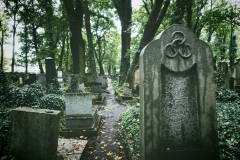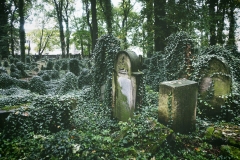The New Jewish Cemetery in Krakow, Poland, was founded in 1800. Following the Nazi invasion of Poland in World War II, the New Cemetery was closed to outsiders and the Germans sold the most valuable stonework to local masons. Other headstones, as well as slabs, were turned into construction material and used for paving the supply road to the camp, including the courtyard of commandant Amon Göth, who is known for having insisted that the Jews pay for their own executions. Meanwhile, the old bones at the cemetery were often left uncovered and scattered around in what looked like an open-pit mine. Soon after the war ended, a local civil engineer identified only as Mr. Stendig, likely Jakub Stendig, a camp survivor, recovered many tombstones from the Płaszów camp site, and arranged to have them reinstalled at the New Cemetery. (Source: Wikipedia).
















